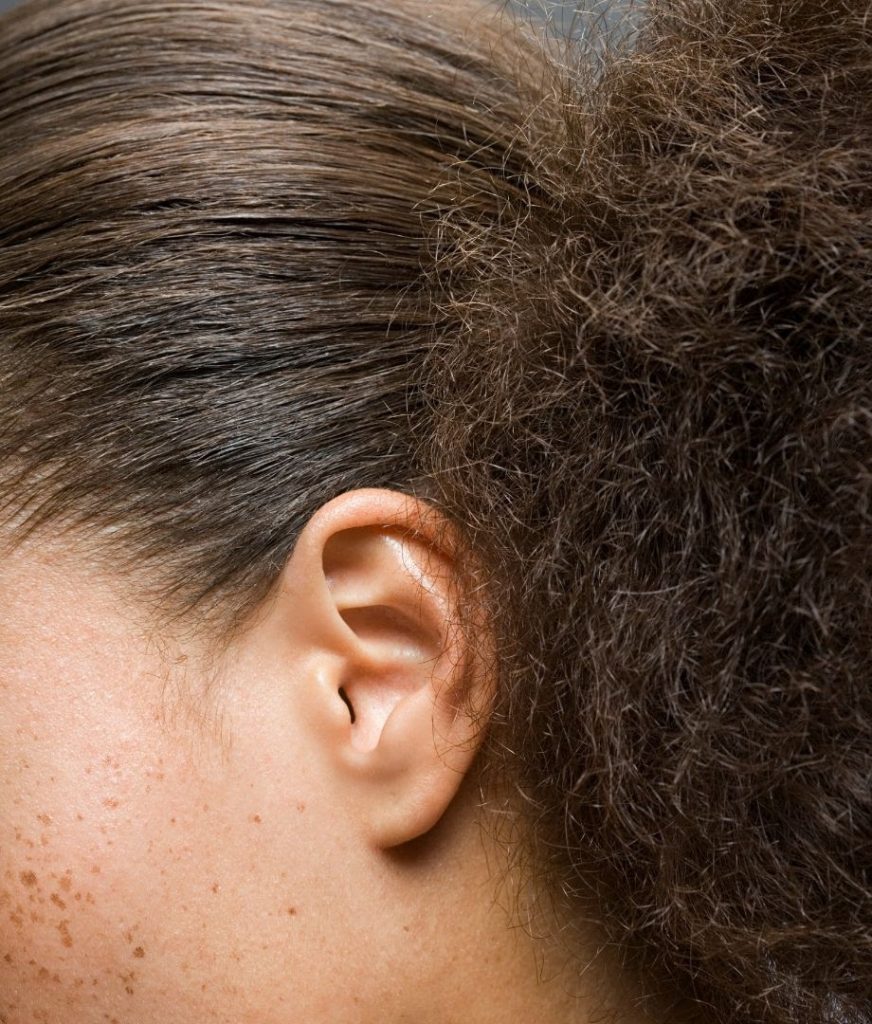Bouncing Back From Breakage In Four Ways
12 June 2021
You might not expect to hear it from us, but problems with breakage are not miraculously solved with product alone. Below we’ll break down a few ways to diagnose the cause, to guard against shedding and how you can fortify your strands going forward.

It has been only in very, very recent memory where I see some actresses have had the gall to sport a realistic textured hair bedtime scene on television, complete with the unsexy bonnet and/or a protective style. And doing so without an air of comedy around it. What’s been going on is a normalisation of what’s really real, and it just doses me with a deep sense of satisfaction each time.
Often as a child growing up, I understood the ridicule of seeing women in their bonnet was meant to suggest that covering my head at night was not normal (read: ghetto). Therein budded my resistance to the idea, and with it losing a true sense of understanding of how to care for my hair. This of course resulted in my hair being dry, more brittle and frizzy. It would then perpetuate into split ends and of course a lot of breakage.
Self care is many things, and for many women that very much includes maintaining healthy hair.
Experiencing breakage is an awful letdown. It can happen not just in how you are sleeping at night, but with how you are styling your hair, how your hair is managing with the air quality/moisture/humidity outdoors, and what is going on with your body’s wellbeing overall.
Here Are 4 Areas To Help Diagnose The Source of Your Breakage & 4 Ways You Can Bounce Back:
1. How Are You Doing Overall
Experiencing hair loss and breakage is much more than physical. In many ways the outputs we see as changes with our body emanate from a biological shift that can range anywhere from a reaction to stress to a symptom of a potentially more serious medical condition. Have a check in with yourself first to assess whether there are any correlations externally or internally with the timing of when you are noticing your hair is shedding more than normal. Are you physically experiencing any other symptoms? Have you had any sudden changes mentally or emotionally that could be triggering an imbalance biologically? Sometimes increased shedding is your body visually communicating something that which you otherwise you may not see or realise. However, as a caveat, it should be mentioned that sometimes your body is going through cycles (think about when you’ve periodically witnessed your skin shedding). A little bit of shedding is absolutely normal. It is the extensive or consistent shedding that we are noting here. There is no such thing as hair that never sheds–not even the surgically applied tresses on the most bomb wig. So let’s just move past that misconception.

2. How Have You Been Treating or Styling Your Hair Recently
This area is the most widely understood reason for why your hair may be breaking. Your former hairstyle was super cute but caused way too much tension on your scalp and strands. Or maybe there was a period of over-utilising heating tools to achieve a certain look. Perhaps you coloured your hair (yes, not great) and then did something crazyyy like dipping into a chlorine pool and then going for a relaxer a mere week later.
(Hi, this was me. I was her 🤦🏾♀️).Or perhaps you have moved into less harmful practises with your hair and the breakage you are witnesses is a result of blossoming change (i.e. transitioning your hair from chemically treated to natural). When this happens, the natural hair coming out of your scalp is now a different texture than the processed end it is attached to. Because of this, the exact meeting point of those two textures (known as the demarcation point) is very weak and susceptible to breakage. But good news! With attention and proper care this can actually be managed (products for transitioning hair).
Also, one more note: Whether you wear a wig consistently or you tend to go on for extended periods (like, a month) without washing your hair, you should know that if your scalp isn’t regularly getting air because it is suffering under sebum or effectively producing oil and sweat under a cap without reprieve, the clogging of your hair follicles will not only stifle your hair’s growth, but may be aiding in the shedding you are witnessing.

3. What Is Your Daily Physical Environment Like
It’s quite normal not to realise that the food we eat, the hardness of the water we drink and bathe in, as well as the climate of the environment for which you are present can all impact the ability of your hair to retain moisture or maintain the vitamin and protein levels it requires to thrive. Has your diet changed recently? Have you moved or just returned from a journey of which the origin was an entirely different climate than your hair is accustomed? Even the change in seasons can be a contributing factor causing you to wonder why your hair is acting up.
4. What Tools Are You Using To Protect Your Hair
Some of us were fortunate enough to be guided by mummy, gran or auntie from school age about the fine art of protecting your precious locks. The bonnet is perhaps the most widely recognised symbol of this, but you may not realise that hair protection does not start and end with preventing next morning bed head.
Would you consider your current hair care routine to be proactive in preventing breakage? This would include whether you completed your wash day with your hair looking and feeling moisturised. Whether or not you are detangling your hair AND being able to detangle with relative ease without having to tear through your strands.
Are you instituting methods to protect both your edges and the ends of your hair? Are the tools you are using (such as combs and brushes) pulling at your hair or irritating your scalp?
You may have also heard that gathering your hair regularly in tight updo’s and using elastics that are rubber or cotton lined will not help your cause. This is absolutely true.

Okay So Now That It’s Laid Out Bare, How Do We Focus on Moving Forward?! Right.
1. Get a Health Check: If you are sensing that your levels of shedding are abnormal for you and your are recognising other symptoms that unusual, consider making an appointment with your GP for a health check. Sometimes our bodies have a way of doing shocking and random things. See this as a form of communication–a signal for us to pay attention to a burgeoning biological shift.
2. Treat Your Hair With Less Force: Again, you hair is communicating with you. If a certain style has resulted in you seeing thinning or weaker strands, then consider accepting that signal and changing course altogether. Sometimes it may be difficult to break habits like, for example, discontinuing the frequency of using heating tools or refraining from keeping your hair in braids for months on end. It is an executive decision. If the causation is clear, but you aren’t interested in changing your practise, there is no regrowth serum that will save you.It’s never too late to pick up a few cues from social media so that you can discover styles that are agreeable with what your hair can manage. Don’t be afraid to book an appointment with a hairdresser simply to learn about styles that you can manage from home. Also, wigs and extensions ARE a really great way to give yourself a break and reset on a hair health plan, all while visibly maintaining your appearance while you sort it through. Sulfates (typically the sudsy ingredient in common shampoos) can be particularly drying for textured hair. If after washing your hair, you’re noticing a cake-y and dry consistency, it may be right for you to consider switching to a sulfate-free shampoo or co-washing. Some sulfate-free washes are no-suds (which you may actually like, especially if you have sensitive skin), but there are also premium formulas which still replicate the sudsy feeling of cleansing your hair without having sulfates stripping your locks of the necessary oils needed to keep your strands healthy and strong.

3. Adapt Your Hair to Fit Your Surroundings
There is a science to this. Adjusting your hair routine, even slightly, to shield your hair from a harsh Winter, and then modifying course to prepare for a humid Summer is smart. Adding like a “pre-poo“, or increasing your deep conditioning treatments from bi-weekly to weekly are great ways to ramp up moisture-enrichment in arid conditions. Humidity defences such as silicone-free hair serums, hair mists, butters and mousses are great additions if you are battling frizziness and split ends.
Whether you are taking more time for exercise or sweating from the heat, increased sebum production will ensue. Decrease your length of time between wash days, or periodically tackle the build up with clarifying products. A clean scalp will breath and grow, and will aid in your breakage battle.
Additionally, if you live in a hard water area (very common in cities), consider filtering the water you are drinking and washing your hair with.
4. Be Proactive About Anti-Breakage With Your Hair Routine
Ah, yes. Back to my initial story, for which the moral is: To Hell with Societal Pressure. I used to do the absolute most when I would sleep at my boyfriend’s flat trying to go to sleep like a princess. I would contort my neck through the night so as to maintain my sleek look in the morning without having to expose him to my dreaded headscarf.
One day I was just fed up with the lie and packed my scarf in my tote. When I pulled it out and proceeded to tie my hair up, he commented about it. Knowing this was coming, I cheekily retorted “What? I’m a Black woman. Have you not dated Black women before?!” I probably puffed up my chest a little too much, but that was me finally freeing myself from unrealistic standards and letting him be on the receiving end of relieving that pressure. Just a little side note though: We’re still together. 😉
A proactive routine looks like planning for solutions that offer ease or relief where your hair is suffering.

The goal is to be mindful about caring for your strands and putting measures in place to prevent it from getting to the point of breakage altogether. That includes:Regular Water Consumption
Providing Your Hair With Vitamins Such As Biotin
Periodic Hot Oil Treatments
Moisture-Inducing Deep Conditioners
Periodic Protein Treatments
Creamy Detanglers
Detangling Your Hair While It’s Wet (Pro tip: using warm water to re-wet the strands is a good aid)
Wide Tooth Combs such as this comb
Heat Controlled Styling Tools
Micro-Fibre Towels to For Drying Instead of Cotton
Silk/Satin Pillowcases
Silk/Satin Night Caps and Scrunchies
Silk/Satin Coverings to Protect The Base of the Hair (And the Ends As Well If Your Ends Are Drier In the Morning)
Ingredients such as Flaxseed, Jamaican Black Castor Oil, Vitamin D and Vitamin E will aid in regrowth of your hair.
Let us know if you are enjoying our content, or if you have any follow up questions.

